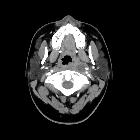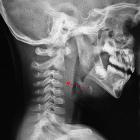parapharyngeal abscess

Parapharyngeal abscesses are deep neck abscesses involving the parapharyngeal space. It is a serious medical condition, potentially fatal, and requires prompt diagnosis and treatment.
Epidemiology
A person of any age can develop a parapharyngeal abscess, but it is most commonly seen in children and adolescents . Immunocompromised adults are also at an increased risk .
Clinical presentation
Presentation is variable, the first symptoms of a parapharyngeal abscess are similar to those of uncomplicated acute pharyngitis or tonsiliits (fever, sore throat, nasal voice, dysphonia, cervical lymphadenopathy). Progression of the signs and symptoms is key as it pertains to inflammation and obstruction of the upper airways and/or gastrointestinal tract and there may be dysphagia, dyspnea, stridor, neck stiffness, drooling, trismus and/or chest pain.
Pathology
Usually, parapharyngeal abscesses arise secondary to oropharyngeal infections that spread either by direct continuity or by lymphatic drainage:
- acute and chronic tonsillitis
- bursting of peritonsillar abscess
- dental infection usually comes from the lower last molar tooth
- Bezold abscess
- petrositis
- spread from other deep head and neck spaces (e.g. parotid, retropharyngeal or submandibular spaces)
- secondary to penetrating trauma of the neck
- iatrogenic e.g. injection of local anesthetic for tonsillectomy or mandibular nerve block
Treatment and prognosis
When a parapharyngeal abscess is detected, treatment should commence immediately. It can usually be treated with broad-spectrum parenteral antibiotics and surgical drainage. Occasionally, small abscesses can be treated with IV antibiotics alone .
Complications
Parapharyngeal space infections are important causes of morbidity and mortality due to possible complications including :
- acute edema of larynx with airway obstruction
- thrombophlebitis of jugular vein with septicemia (Lemierre syndrome)
- spread of infection to retropharyngeal space
- spread of infection to mediastinum along the carotid space or danger space
- mycotic aneurysm with possible subsequent rupture of the internal carotid artery
- carotid blowout with massive hemorrhage
Siehe auch:

 Assoziationen und Differentialdiagnosen zu parapharyngealer Abszess:
Assoziationen und Differentialdiagnosen zu parapharyngealer Abszess:




